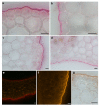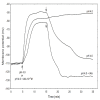Some New Methodological and Conceptual Aspects of the "Acid Growth Theory" for the Auxin Action in Maize (Zea mays L.) Coleoptile Segments: Do Acid- and Auxin-Induced Rapid Growth Differ in Their Mechanisms?
- PMID: 33652568
- PMCID: PMC7956494
- DOI: 10.3390/ijms22052317
Some New Methodological and Conceptual Aspects of the "Acid Growth Theory" for the Auxin Action in Maize (Zea mays L.) Coleoptile Segments: Do Acid- and Auxin-Induced Rapid Growth Differ in Their Mechanisms?
Abstract
Two arguments against the "acid growth theory" of auxin-induced growth were re-examined. First, the lack of a correlation between the IAA-induced growth and medium acidification, which is mainly due to the cuticle, which is a barrier for proton diffusion. Second, acid- and the IAA-induced growth are additive processes, which means that acid and the IAA act via different mechanisms. Here, growth, medium pH, and membrane potential (in some experiments) were simultaneously measured using non-abraded and non-peeled segments but with the incubation medium having access to their lumen. Using such an approach significantly enhances both the IAA-induced growth and proton extrusion (similar to that of abraded segments). Staining the cuticle on the outer and inner epidermis of the coleoptile segments showed that the cuticle architecture differs on both sides of the segments. The dose-response curves for the IAA-induced growth and proton extrusion were bell-shaped with the maximum at 10-4 M over 10 h. The kinetics of the IAA-induced hyperpolarisation was similar to that of the rapid phase of the IAA-induced growth. It is also proposed that the K+/H+ co-transporters are involved in acid-induced growth and that the combined effect of the K+ channels and K+/ H+ co-transporters is responsible for the IAA-induced growth. These findings support the "acid growth theory" of auxin action.
Keywords: auxin; coleoptile segments; growth; membrane potential; proton extrusion.
Conflict of interest statement
The authors declare no conflict of interest.
Figures









Similar articles
-
Role of chloride ions in the promotion of auxin-induced growth of maize coleoptile segments.Ann Bot. 2014 Oct;114(5):1023-34. doi: 10.1093/aob/mcu170. Epub 2014 Aug 16. Ann Bot. 2014. PMID: 25129632 Free PMC article.
-
Fusicoccin (FC)-Induced Rapid Growth, Proton Extrusion and Membrane Potential Changes in Maize (Zea mays L.) Coleoptile Cells: Comparison to Auxin Responses.Int J Mol Sci. 2021 May 9;22(9):5017. doi: 10.3390/ijms22095017. Int J Mol Sci. 2021. PMID: 34065110 Free PMC article.
-
A comparison of the effects of IAA and 4-Cl-IAA on growth, proton secretion and membrane potential in maize coleoptile segments.J Exp Bot. 2002 May;53(371):1089-98. doi: 10.1093/jexbot/53.371.1089. J Exp Bot. 2002. PMID: 11971920
-
Growth-limiting proteins in maize coleoptiles and the auxin-brassinosteroid hypothesis of mesocotyl elongation.Protoplasma. 2016 Jan;253(1):3-14. doi: 10.1007/s00709-015-0787-4. Epub 2015 Mar 15. Protoplasma. 2016. PMID: 25772679 Free PMC article. Review.
-
Synthesis and regulation of auxin and abscisic acid in maize.Plant Signal Behav. 2021 Jul 3;16(7):1891756. doi: 10.1080/15592324.2021.1891756. Epub 2021 May 30. Plant Signal Behav. 2021. PMID: 34057034 Free PMC article. Review.
Cited by
-
Have All of the Phytohormonal Properties of Melatonin Been Verified?Int J Mol Sci. 2024 Mar 21;25(6):3550. doi: 10.3390/ijms25063550. Int J Mol Sci. 2024. PMID: 38542522 Free PMC article. Review.
-
The Complexity of the Influence of Growth Substances, Heavy Metals, and Their Combination on the Volume Dynamics of Vacuoles Isolated from Red Beet (Beta vulgaris L.) Taproot Cells.Int J Mol Sci. 2024 Oct 9;25(19):10842. doi: 10.3390/ijms251910842. Int J Mol Sci. 2024. PMID: 39409172 Free PMC article.
-
The Role of Aquaporins in Plant Growth under Conditions of Oxygen Deficiency.Int J Mol Sci. 2022 Sep 5;23(17):10159. doi: 10.3390/ijms231710159. Int J Mol Sci. 2022. PMID: 36077554 Free PMC article. Review.
-
Changes in the morphology traits, anatomical structure of the leaves and transcriptome in Lycium barbarum L. under salt stress.Front Plant Sci. 2023 Feb 20;14:1090366. doi: 10.3389/fpls.2023.1090366. eCollection 2023. Front Plant Sci. 2023. PMID: 36890891 Free PMC article.
-
The effect of DC electric field on the elongation growth, proton extrusion and membrane potential of Zea mays L. coleoptile cells; a laboratory study.BMC Plant Biol. 2022 Aug 3;22(1):389. doi: 10.1186/s12870-022-03778-4. BMC Plant Biol. 2022. PMID: 35922781 Free PMC article.
References
-
- Cleland R.E. Cell wall extension. Annu. Rev. Plant Physiol. 1971;22:197–222. doi: 10.1146/annurev.pp.22.060171.001213. - DOI
-
- Karcz W., Stolarek J., Pietruszka M., Malkowski E. The dose–response curves for IAA-induced elongation growth and acidification of the incubation medium of Zea mays L. coleoptile segments. Physiol. Plant. 1990;80:257–261. doi: 10.1111/j.1399-3054.1990.tb04405.x. - DOI
MeSH terms
Substances
LinkOut - more resources
Full Text Sources
Other Literature Sources

